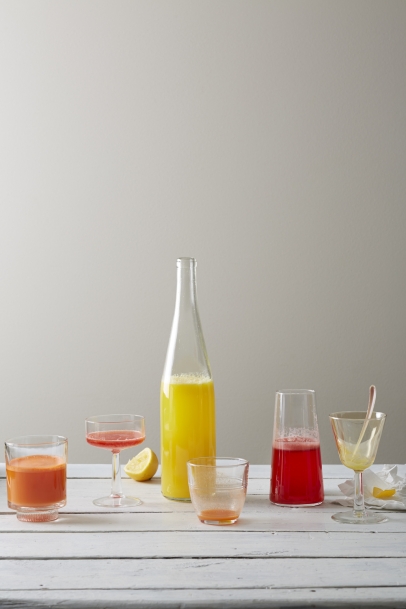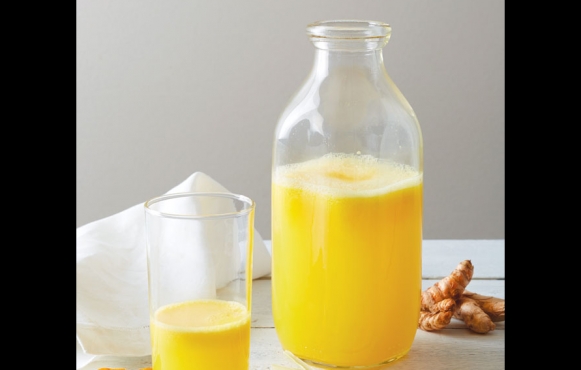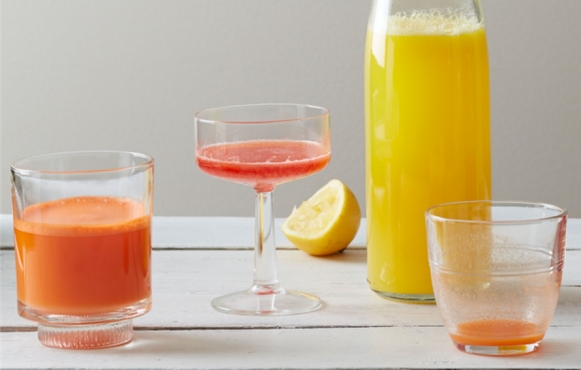Springtime Spirits

Recipe editor Sarah Lagrotteria pairs up with mixologist Nicolene Schwartz to craft culinary juices and cocktails for the arrival of spring.
Historically, botanical ingredients are fundamental to the cocktail. Gin’s piney signature, for example, depends on the juniper berries added during vapor-distillation, and the bitterness in tonic comes from the powdered bark of the South American cinchona tree. A quick scan of a contemporary liquor stockist’s shelves turns up the revised versions—small-batch tonics combine cinchona with dozens of other botanicals, and Columbus’s own Watershed Distillery reimagines gin to include heady citrus and deep spices.
This fascination with botanical and culinary-style ingredients underscores for us interested parties (on both sides of the bar) something fundamental to the enjoyable nature of a modern cocktail. Though a well-executed Manhattan or Vesper is a lovely thing, the fun of a culinary cocktail is in the surprise of the sensory experience—the secret connection between ingredients that an unlikely but well-constructed pairing brings out (for a food parallel, think some of Jeni’s more inventive ice creams). And in the springtime, especially, with botanicals and fresh produce of all varieties in season, this is definitely fun you should try at home.
Famed Chicago chef Greg Achatz describes, “making associations with what smells good or smells a certain way and pairing that with actual edible ingredients” when discussing his creative process. And though he’s referencing food rather than drink, when edible’s team met up at The Seasoned Farmhouse to create spring cocktails, we found this concept of connection applies readily to drink-building as well.
The scene in the Farmhouse’s airy main space presents a compelling visual: bright piles of lemon, grapefruit, orange, and lime contrast the watercolor-subtlety of lemongrass stalks and dried roses; the rich colors of freshly-juiced turmeric, strawberry, and carrot punctuate the palette. Across the room, Ryan Benyi and Bridget Henry tease out the interplay of color and texture among these ingredients as they set up photo shots, while in the kitchen Sarah and I are doing much the same thing with scent and taste.
We start with strawberry. Though the robust sweetness will need to take the lead in the cocktail, it could easily overwhelm if not properly positioned. But the addition of rose adds an airy note, while grapefruit’s dry tang provides the bulk of needed balance to the strawberry. Since this same citrus features prominently in Watershed’s gin, our choice of base spirit is an easy one (see recipe for Strawberry Rose Juice).
Though it seems perhaps counterintuitive, sometimes it takes an association of commonality, rather than contrast, to build a complex flavor profile. We love how ginger’s earthy top notes suggest the renewing, regenerative nature of springtime, but while this nuance comes through as a scent, it is handily doused by the root’s spiciness when put into cocktail form. The addition of carrot juice—whose earthy profile is teased out by the veggie’s mild, non-competitive sweetness—becomes the perfect vehicle for propping up this same subtlety in the ginger. Rye whiskey’s sweet-spicy balance rounds out the ginger’s tang and adds warmth, while a squeeze of lemon juice sharpens the edges.
With perhaps our most delicate ingredients—turmeric and lemongrass—we choose vodka as a base, which adds texture without vying for weight in the flavor profile. Since the citrusy side of lemongrass tends to override its lighter, more floral notes, we use elderflower liqueur to tilt the cocktail further in that direction. Like ginger, turmeric’s earthy-grassy scent is worth emboldening within the cocktail, and a prosecco accomplishes this nicely, the dry effervescence helping to pull those more subtle flavors to the forefront.
Science suggests that when approaching a new scent or taste we contextualize its unfamiliar aspects through association with things that we already know as we work to identify what we’re perceiving. But emboldening as it is to think that our noses and brains might predispose us to a certain dexterity with this kind of cocktail experimenting, as long as the result tastes good to the person drinking it, there’s no wrong answer. And, luckily, the only real way to get good at it is by doing it. The weather’s becoming ever more inviting, after all, and we think this has “fun dinner party” written all over it.








